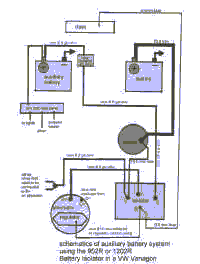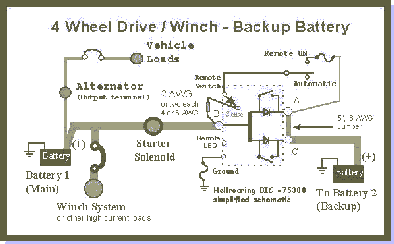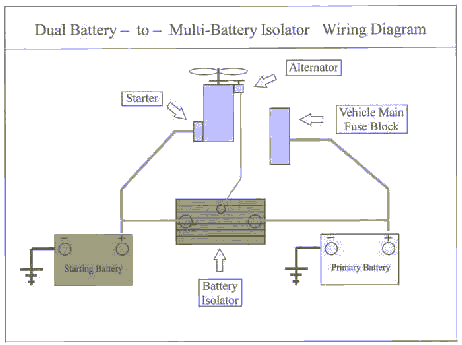[http://www.flexcharge.com/flexcharge_usa/manuals/pv7-pv14_manual.pdf.]
What is the function of blocking diodes in a Photovoltaic (PV) system?1 To prevent the flow of electricity into the panels when the panels are not making electricity, and to prevent voltage spikes in the system from reaching the panels...
----------
[http://www.geocities.com/harald_nancy/isolator.htm ]
Relay versus Isolator?
Some call the dual battery relay a "battery-isolator-relay?
Don't let that confuse you. The relay is not a "battery isolator".
A dual-battery-relay (see "relay" page) is a simple switch,
disconnecting the two batteries, when the engine is turned off.
But the moment the relay reconnects the batteries, the
drained battery robs power from the starting battery.
This sudden transfer of current from one battery to another
can damage batteries, and shorten their life.
That is one of the reasons bigger mobile homes, trucks etc.
mostly use "battery-isolators?for multi-battery installations.
You can also use this isolator technology in a vanagon
to keep two batteries charged.
It is safe to use 2 dissimilar batteries with the isolator.
Example: one old marginal batt. for the aux, and a strong new
batt. for main battery. Or small deep cycle, and regular main batt.
Slight alteration to the regulator is required,
to compensate for the 0.7 v. voltage drop across the diodes.
-----------

[http://www.carsound.com/columns/navone/ ]
Intelligent Circuit Breakers Basically, an ICB looks and functions like a mini dual-battery isolator, however, the voltage drop across a dual-battery isolator at 500 amps would surely limit a "high-end?car audio system. Also, a dual-battery isolator under such conditions would require massive heat sinking fins and large cooling fans. Additionally, the diodes in a dual-battery isolator build up more and more heat as the current increases. This is the same situation as for a fuse. Just when the most current is needed, the dual-battery isolator consumes a maximum amount. The ICB solves this problem because the voltage drop across the semiconductor devices is incredibly small.
=------------------
[http://www.colehersee.com/04resource/faqs.htm ]
What type of Battery Isolator should be used with the Delcotron CS Series alternator?
Use the four terminal Battery Isolator (Cole Hersee 48122, 48092 or 48162). The fourth terminal (#10 stud) is used to excite the alternator .It supplies +12V to the alternator when the ignition switch is turned On.
--------
[http://www.thezeb.com/caraudio/lightningaudiobatteryisolators.html.]
theZEB.com, 174 Crawford Road, Suite D, Statesville, NC 28625; toll-free: 877-922-8346 /or: 704-883-0123 / fax: 704-883-0261 / email: sales@thezeb.com
Lightning Audio Battery Isolators:
Use these high-quality battery isolators to isolate your main battery from your extra batteries. These battery isolators will keep your main battery fully charged before charging your auxiliary batteries. Need help picking out the correct unit? Give us a call.
ISO70 -- 70 amp dual battery isolator Your Price $49.99
ISO95 -- 95 amp dual battery isolator, Your Price $59.99 / /
ISO120 120 amp dual battery isolator, CS $119.95 Your Price $79.99 / /
ISO120G 120 amp dual battery isolator for VW, Mercedes, Porsche, etc. $129.95 Your Price $89.99 / /
ISO160 160 amp dual battery isolator, CS $179.95 Your Price $129.99 / /
ISO240 240 amp dual battery isolator, CS $259.95 Your Price $179.99 / /
ISOHARM Wiring harness for connecting CS style isolator to GM Vehicles $24.95 Your Price $17.99
-------------
[www.dyersonline.com/merchant.mvc?Screen=PROD&Product_Code=55-9418&Category_Code=Electrical-Battery+Isolators ]
Dyer's RV Customer Service Department
1686 E. Auburn Rd.
Rochester Hills, MI 48307 866-713-3429
* SurePower 95 Amp Isolator /
Code: 55-9418 /
Price:$51.95 /
Shipping Weight: 5.00 pounds /
95 amp 2 battery isolator for use with new Delcotron CS Series 121 (50,75 amps) and 130 (85 amps) alternators. For GM vans and light trucks (1986 and up) and some late model Toyota chassis. Use with 50 amp circuit breaker (not included). Includes Wiring Kit.
* SurePower 120 Amp Isolator w/ Wiring Kit Product Code: 55-9419
Price: $72.95
120 amp, 2 battery isolator for Delcotron CS Series 130 (100,105 amps) and 144 (120 amps) alternators. For GM light trucks (1986 and UP) and "P" Series RV chassis (1987 and up). Use with 80A circuit breaker (not included). 1 per pack.
----------
[Battery Isolators & etc, volume II]
{Cole Hersee Isolators]
48122 the 140 amp version for Delcotron alternators: three 5/16" studs and one #10 stud (an extra stud to excite the Alternator
48092 - the 90 amp version of GM Delcotron Isolator
[http://moab.off-road.com/pipermail/jeeptech/msg09365.html ]
The diode types are somewhat unreliable. The diodes
burn out all the time unless the amp rating of the
alternator is LESS than the amp rating of the diode.
Even then they get pretty hot which contributes to
their death (notice all those alluminum cooling fins
on it). With a 90amp alternator an isolator switch is
going to be pretty expensive (like $50 or so, I
think). You should probably go with either a solenoid
type switch (basically a mechanical relay) which will
be more reliable. I prefer either a battery knife
switch or a heavy duty rotary switch. These are
available for around $20 at any auto parts store. The
only problem with any of these is that they aren't
automatic. You have to flip them on and off and if
you forget... The wiring is pretty simple though. I
used to use a triple battery combo in my Dodge. I
used 2 gauge wire from the battery in the front to the
batterys in the back. This way, I could actually
start off either set of batteries. I isolated them
with a mechanical rotary switch with a very high amp
rating (a $20 switch). This setup has worked
flawlessly for me for over five years. Those
isolators are pretty cool though. I had one once and
it burned out (of course) and I had to rewire the rig
on the side of the highway to get it to run. Not fun.
------------------------------
[http://www.yandina.com/combInfo.htm ]
When you use a battery ISOLATOR, it has a built in diode voltage drop of about 0.6 volts, even when no current is flowing. This makes a significant difference to the charge accepted by the battery. To overcome this, the external sense wire can be connected directly to the battery so the alternator will raise it's output by the 0.6 volts to get the sense wire up to the correct full charge voltage.
In simple installations this will work OK but typically in boats or RVs, with selector switches and multiple battery banks, it is a disaster waiting to happen. If the sense wire is switched to the starting battery, and the alternator on the house battery then the house battery will be overcharged. The owner sensing something is wrong turns the alternator selector switch off, now disconnecting the battery load from the alternator. The sense wire is still calling for charge so the output of the alternator (now without any load) raises to over 100 volts with all the house battery items - electronics, lamps, instruments, etc., still connected to it!!!
So the fewer switches, fuses, wiring or anything that can cause the wrong voltage to come back on the sense wire, the safer in general you will be. This, in essence, is one of the main advantages of a COMBINER over an ISOLATOR. In combiner hookups, the alternator is directly connected to one of the batteries with no diodes in between which introduce a voltage drop or which can open circuit (or short circuit) on overload. Since it is a direct connection, there is no longer any need to bring the sense wire out to the battery so the whole setup is much safer.
-----------------------------
SURGE
PROTECTORS
The ZAP stop:-
While on the alternator subject, another area of concern is the alternator output cable going to the battery. Even with the sense wire eliminated or connected directly to the alternator output, there is always some delay in the regulator/alternator system response time (milliseconds) so if a switch is opened between the alternator output and the battery the current is flowing into, the sudden removal of that load allows the alternator output to produce a high voltage spike. Within milliseconds the regulator cuts it down but never quick enough to stop the spike. This spike can kill electronic equipment and can damage the alternator rectifiers.
So in any alternator circuit that has a switch between the alternator and the battery, you should install a "Zap Stop" from the alternator output terminal to ground (metal frame of engine). These are voltage sensitive devices which turn on as soon as the voltage starts to rise too high and absorb the spike. They should be connected right on the alternator or as close as possible. On some engines, especially outboards, the closest location you can place it may have to be on the starter motor positive terminal and ground.
West Marine stores carry them for about $25 list - cheap insurance. They can only absorb the spike for a few thousandths of a second which means they CANNOT provide protection for the extended high voltage conditions mentioned above.
------
{ZAP STOP}
[From West Marine online store] [http://www.westmarine.com ]
At least once in every boater's life, someone will turn the battery switch to OFF with the engine ON. This usually damages one or more of the alternator diodes, since the voltage rises quickly above the limits of the diodes, leaving you without a way to charge your batteries. $25.
Dual-output alternators will require a Zap Stop for each positive output terminal / /
Special diode will protect your alternator from damage / /
Simple installation
------------
[ http://www.geocities.com/bill_dietrich/BoatElectrical.html.]
The Zap Stop explained:
A zap stop is not a fuse. It is not associated directly with the ignition or battery switch. It connects between any 12 volt circuit and ground with 12 volts across it. While the voltage remains within normal operating limits, it has zero effect, but if the voltage rises too high, it starts to conduct electricity and absorb the high voltage to protect alternator diodes, electronics, light bulbs, etc.
A typical installation point is across the alternator output. Alternators can self destruct if disconnected from their load (battery) while they are charging. The reason is the current put out by the alternator is being regulated by the regulator and it uses battery voltage to determine how much current to produce. If you remove it from the load while it is charging, the voltage suddenly rises since the current no longer has a load to absorb it. This sudden rise is immediately detected by the regulator but it has to change the excitation voltage on the alternator and this process takes a few thousandths of a second before it is again under control. During those few thousandths of a second, the voltage can reach hundreds of volts - enough to self-destruct the alternator and any other electronic devices that were disconnected from the battery with it.
The zap stop can absorb hundreds of amps for a few thousandths of a second and limit this voltage spike to safe limits to provide the protection. All boats should install one across their alternator as a safety precaution, especially if using an isolator or if the alternator output can be switched. With a battery combiner, however, the alternator output is always directly connected to a battery so they are not necessary.
Another place for them is across the bus bar that supplies power to your electronics panel to protect against a voltage spike, in particular for protection from the induced voltage of a nearby lightning strike that just missed you.
They cannot protect against loss of regulation on an external sense alternator where the sense lead becomes disconnected or grounded. Although they absorb the initial spike, if it lasts for more than a few thousandths of a second, the zap stop will overheat and self-destruct too. With say 25 volts across it, and say 200 amps flowing through it, the heat build up is 5,000 watts so it can only absorb this for a few thousandths of a second before overheating.
West Marine sells the Heart brand - price about $25.
A "Zap Stop" Criticism:



 MATSON'S ANTIZAP® SURGE PROTECTOR SAVES ELECTRICAL SYSTEMS
MATSON'S ANTIZAP® SURGE PROTECTOR SAVES ELECTRICAL SYSTEMS